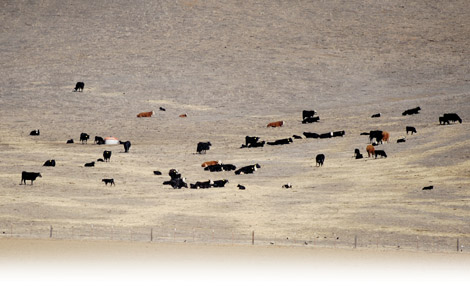Local residents in the cattle industry were taken aback by environmental goals included in the county’s long-developing general plan – a document that will act as a blueprint for future development – which called for an 80 percent reduction to the local herd by 2035.
Cattlemen expressed their disapproval during the recently finished comment period for the general plan update – a $1.25 million revision put together by consultants and developed over the past five years with guidance from a citizen-based, supervisor-appointed committee and county staff officials.
Particularly stunning for the San Benito Cattlemen’s Association, which submitted a critical letter that called the projected cattle reduction an “erroneous calculation,” was the section in the document addressing “Global Climate Change.”
The organization pointed out that the chapter includes expectations for cattle emissions to drop from 75,093 metric tons per year in 2010 to 14,675 metric tons per year in 2035 – and that the chapter projects the total number of cattle to decline from 35,800 to 6,988 over the same span, an 80 percent decrease.
“How is that possible and what brought the questionably inept and incompetent consulting firm to this erroneous calculation?” cattlemen’s association President Allen Renz wrote in the letter.
The letter goes on to demand that the “possibly fraudulent document be corrected” to reflect true numbers and it questions “how much of the rest of the information in this entire document appears to be as erroneous” as the cattle numbers.
A general plan is considered a municipality’s guiding blueprint for long-term development – until 2035 in the case of San Benito County’s revision. That update is entering its final stages before prospective approval by the board of supervisors in late summer, but a county staff official and the consultant indicated to the Free Lance that the section with those cattle figures would be revised, and the sharp reduction scaled back.
County Planning Director Gary Armstrong, who is departing for a new job in Costa Mesa, said staff members caught the irregularity during the document’s review and informed the consultant to amend it. Still, he said the figures “slipped through he cracks” and now it has left “egg on our face.” Armstrong said the figures are “not something the county planning staff is in agreement with” and that to his knowledge, there was never any discussion about the cattle reduction projections in the general plan committee meetings.
“We suggested to the consultant – we didn’t believe that was going to happen in our county,” Armstrong said. “We’d asked them to re-look or revise that and somehow that slipped through the cracks.”
Armstrong said he doesn’t believe it could be a sign that the consultant may misunderstand the county’s makeup in other areas of the lengthy document.
“No, I don’t think so,” he said. “I think they’ve done a really good job of doing their research. They’ve done many general plans in rural counties.”
Jim Harnish, principal in the Sacramento-based consulting firm Mintier Harnish that put together the general plan draft, said the environmental portion was coordinated by a commonly used subconsultant, Tim Rimpo, an air quality control manager with Environmental Science Associates. Mintier Harnish routinely uses certain subconsultants for specialties, such as Rimpo for environmental analysis, Harnish said.
He was in communication with Rimpo this week about the cattle numbers, he said.
As for how the subconsultant came to the figures, Harnish said the related general plan documents note the source of information for the projected decrease as the agriculture commissioner’s crop reports – while the county agency’s website posts those reports as far back as 1941.
According to those crop reports, between 1990 and 2010, cattle head numbers declined from 58,850 to 35,800. That represents a 39 percent decrease.
Harnish and Armstrong also acknowledged that state laws pertaining to emission reduction largely focus on transportation matters.
“I’m not aware of a specific formula where they’re being prejudicial to cows,” Armstrong said of the state. “I don’t know where it came from, to be quite honest.”
Harnish said “almost the entire focus” of emission control legislation is on vehicle travel and energy consumption.
The general plan draft does, however, note that when data are isolated to rural, unincorporated San Benito County, agriculture accounts for about one-third of all greenhouse emissions. Transportation accounts for about 26 percent more greenhouse emissions than agriculture, according to the draft.
“Cattle is certainly another (industry) that greatly contributes to the greenhouse gases that are produced,” Armstrong said.
In general, though, the amounts don’t cause a relatively significant impact because cattle need a broad range of open-air space and aren’t usually concentrated, Harnish said. He said he had never heard of another general plan process in which such agriculture emission figures caused an issue.
He said there was no intention to promote a reduction in cattle numbers.
“That’s not true,” Harnish said. “That’s never been discussed. We’ll get to the bottom of the projections.”
CATTLE NUMBERS
2010: 35,800
2009: 39,400
1990: 58,850
1989: 59,030
That represents a 39 percent decrease in 20 years. The general plan’s projected reduction over the next 25 years – with a goal of greenhouse gas reduction – would decrease the local herd by another 80 percent.
Source of cattle head figures: Ag commissioner’s report







